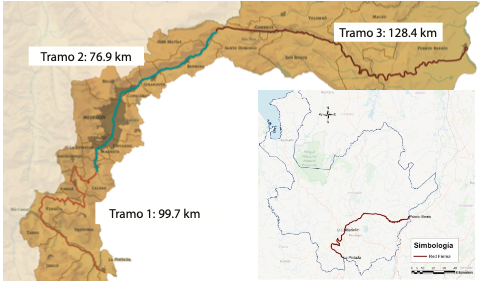Traction system choice for the Multipurpose Railway of Antioquia
Elección de sistema de tracción para el Sistema Férreo Multipropósito de Antioquia


This work is licensed under a Creative Commons Attribution-NonCommercial-NoDerivatives 4.0 International License.
Copyright statement
The authors exclusively assign to the Universidad EIA, with the power to assign to third parties, all the exploitation rights that derive from the works that are accepted for publication in the Revista EIA, as well as in any product derived from it and, in in particular, those of reproduction, distribution, public communication (including interactive making available) and transformation (including adaptation, modification and, where appropriate, translation), for all types of exploitation (by way of example and not limitation : in paper, electronic, online, computer or audiovisual format, as well as in any other format, even for promotional or advertising purposes and / or for the production of derivative products), for a worldwide territorial scope and for the entire duration of the rights provided for in the current published text of the Intellectual Property Law. This assignment will be made by the authors without the right to any type of remuneration or compensation.
Consequently, the author may not publish or disseminate the works that are selected for publication in the Revista EIA, neither totally nor partially, nor authorize their publication to third parties, without the prior express authorization, requested and granted in writing, from the Univeridad EIA.
Show authors biography
This paper presents an analysis of different railway traction alternatives, including diesel- electric traction, natural gas traction and electric traction. Based on the reviewed literature, the different advantages and disadvantages of each traction system alternative are presented, showing under which conditions each traction system presents greater strengths in its application. Thus, for various environmental factors and system costs, the best alternative to use under the Antioquia railway conditions is presented. Finally, the use of diesel-electric trains for the freight transport and urban solid waste (MSW) is recommended, while it is recommended to implement electric traction for the section in which passengers are expected to be transported, due to the high expected traffic of this type of train.
Article visits 558 | PDF visits 307
Downloads
- Announcements, 1983. Transport and storage of LPG and LNG. International Journal of Pressure Vessels and Piping, Volumen 12, p. 191.
- BNSF Railway Company, Union Pacific Railroad Company, The Association of American Railroads, California Environmental Associates, 2007. An Evaluation of Natural Gas-fueled Locomotives, Los Angeles: s.n.
- Consorcio Ferrocarril de Antioquia 2017 – CFA2017, 2018. Estructuración de la solución técnica, económica, legal, predial, social y ambiental para la reactivación del ferrocarril de Antioquia como tren multipropósito entre el municipio de la Pintada y el municipio de Puerto Berrío, Medellín: s.n.
- Friedemann, A., 2017. Energyskeptic. [En línea]
- Available at: http://energyskeptic.com/2017/can-railroad-locomotives-run-on-lng/
- [Último acceso: 15 Diciembre 2017].
- García Álvarez, A., 2008. Consumo de energía y emisiones del tren de alta velocidad. En: La importancia de la velocidad en el ferrocarril. Córdoba: Fundación Caminos de Hierro.
- García Álvarez, A., 2009. Comparación medioambiental entre la tracción eléctrica y la tracción diésel en el ferrocarril. Anales de Mecánica y Electricidad, 86(1), pp. 53-66.
- García Álvarez, A., 2009. La electrificación ferroviaria cada vez más necesaria y eficiente. Anales de Mecánica y Electricidad, 86(3), pp. 8-15.
- García Álvarez, A., 2010. High speed, energy consumption and emissions, Madrid: Study and Research Group for Railway Energy and emissions.
- García Álvarez, A., 2011. Energía y emisiones en el transporte por ferrocarril. Madrid: Fundación de los Ferrocarriles Españoles.
- González Franco, I., 2012. Estimación del consumo de energía y emisisones de CO2 en trenes de mercancías y análisis de la variabilidad. Madrid: Fundación de los Ferrocarriles Españoles.
- Hai, L., 1993. Heat transfer model applicable to the refuelling process for natural gas, Melbourne: s.n.
- Insa Franco, R. y otros, 2016. Monitorización, modelización y simulación del consumo energético en el ferrocarril. Valencia: Editorial UPV.
- International Energy Agency, 2010. The contribution of natural gas vehicles to sustainable transport, París: IEA Energy Papers. OECD Publishing.
- International Energy Agency, 2016. Key World Energy STATISTICS. s.l.:s.n.
- Kim, K. & Chien, S. I., 2010. Optimal train operation for minimum energy consumption considering schedule adherence. TRB Anual Meeting Compendium. Transportation Research Board.
- Kosinski, A., Schipper, L. & Deakin, E., 2011. Analysis of high-speed rail's potential to reduce CO2 emissions from transportation in the United States. TRB Annual Meeting Compendium. Transportation Research Board.
- López Pita, A., 2008. Explotación de líneas de ferrocarril. Barcelona: Ediciones UPC.
- Pineda-Jaramillo, J. D., Insa, R. & Martínez, P., 2017. Modeling the energy consumption of trains by applying neural networks. Proceedings of the Institution of Mechanical Engineers Part F Journal of Rail and Rapid Transit, 232(3), pp. 816-823.
- Pineda-Jaramillo, J. D., Salvador, P. & Insa, R., 2017. Comparing energy consumption for rail transit routes through Symmetric Vertical Sinusoid Alignments (SVSA), and applying artificial neural networks. A case study of Metro Valencia (Spain). DYNA, 84(203), pp. 17-23.
- Promotora Ferrocarril de Antioquia, 2017. Consultoría especializada para la estructuración de la solución para la reactivación del ferrocarril en Antioquia como tren munltipropósito entre La Pintada y Puerto Berrío - Anexo 4, Medellín: s.n.
- Read, M., Griffiths, C. & Smith, R., 2011. The effect of driving strategy on hybrid regional diesel trains. Journal of Rail and Rapid Transit, Volumen 225, pp. 236-244.
- Salvador, P., Martínez, P., Villalba, I. & Insa, R., 2017. Modelling energy consumption in diesel multiple units. Proceedings of the Institution of Mechanical Engineers Part F Journal of Rail and Rapid Transit.
- Schulte, I., 2004. Issues affecting the acceptance of hydrogen fuel. International Journal of Hydrogen Energy, 29(7), pp. 677-685.
- Sun, Y., Cole, C., Spiryagin, M. & al, e., 2014. Longitudinal heavy haul train simulations and energy analysis for typical Australian track routes. Journal of Rail and Rapid Transit, Volumen 228, pp. 355-366.
- Zhang, T., 2015. Possibilities of alternative vehicle fuels - A literature review, Gävle: s.n.




